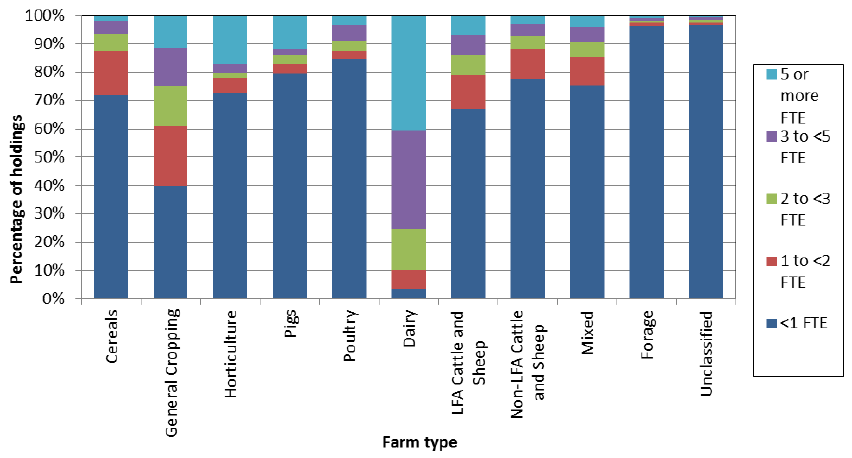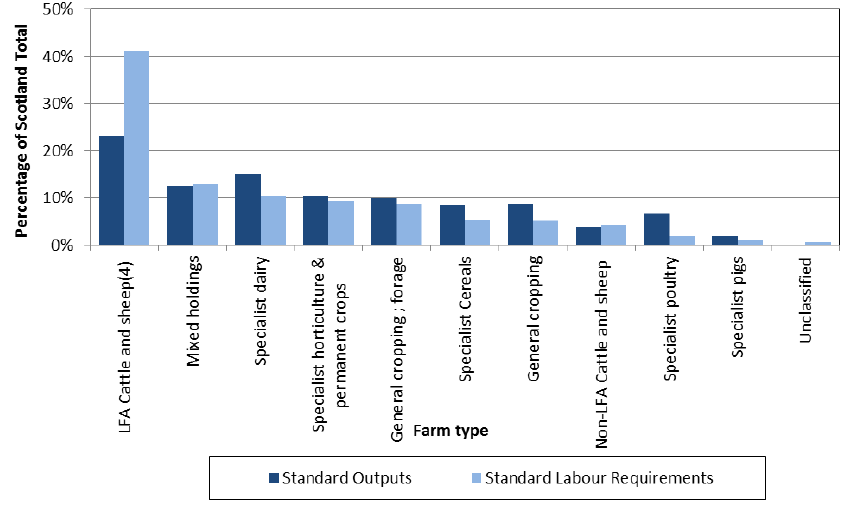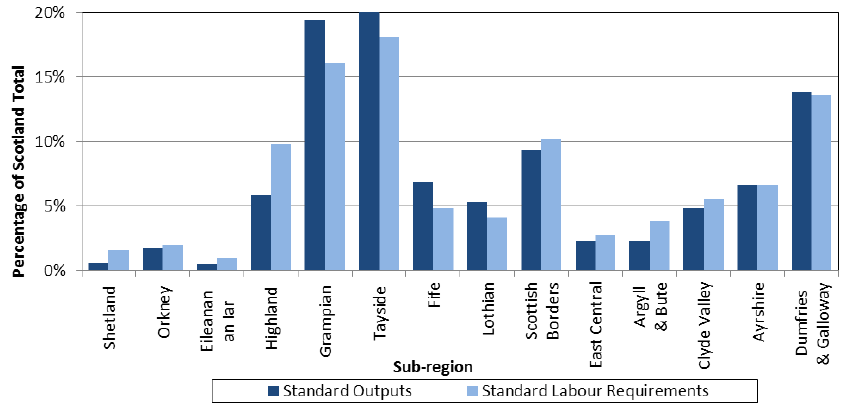Economic Report on Scottish Agriculture 2015
Economic Report on Scottish Agriculture 2015 presenting an overall picture of Scottish agriculture using data from the various agricultural surveys that RESAS manage.
7.3 Standard Labour Requirements (Tables C23, C25, C26)
Standard Labour Requirements (SLR) represent the notional amount of labour required by a holding to carry out all of its agricultural activity and is also used as a measure of farm size. Standard Labour Requirements are derived at an aggregate level for each agricultural activity. The total SLR for each farm is calculated by multiplying its crop areas and livestock numbers by the appropriate SLR coefficients and then summing the results for all agricultural activity on that farm. One SLR equates to 1,900 working hours per year.
The SLR coefficients used in this publication are based on values in the year 2004 and have been applied to the 2014 crop areas and livestock units of holdings.
The total SLR for Scotland was 46,700 full time equivalent workers, averaging 0.89 per holding. The SLR full-time equivalent total was less than the total labour figure reported in section 7.1, due to the fact that the labour total (66,300 people) is a headcount (i.e. a part-time worker working for a year would equate to less than one SLR).
Chart 7.5: Standard Labour Requirements by farm type, June 2014

Chart 7.5 shows the SLR distribution by farm type. It shows that just three per cent of dairy holdings had an SLR of less than one full-time equivalent (FTE) and 76 per cent had an SLR of three or more.
General cropping (60 per cent) was the only other farm type where the majority of holdings had an SLR of one or more. Farm types which had the highest proportions of holdings with less than one SLR, and thus can be viewed as requiring less labour in general over the year, were unclassified holdings (97 per cent), forage (96 per cent), specialist poultry (85 per cent), specialist pig (79 per cent) and non-LFA cattle & sheep (78 per cent). However, it should be noted that those holdings with more than one SLR among farm types such as specialist pig and poultry account for a large proportion of output in these sectors, due to their highly concentrated production (as illustrated in sections 5.4.2 and 5.5.2 respectively).
Please note also that SLR is a measure of labour requirement averaged over the whole year. Therefore, where a large number of workers are casual or seasonal labour, such as is likely in horticulture, these will not necessarily equate to a large SLR.
Chart 7.6 shows the share of national SLRs by farm type, providing comparison with Standard Outputs (SO). Cattle & sheep (LFA) holdings accounted for 41 per cent of total SLRs compared to their 23 per cent share of SO. This means that this farm type had a much higher labour requirement in proportion to its total SO.
By contrast, most other farm types, including general cropping, horticulture, poultry, pigs, dairy and cereals holdings had a higher share of Scotland’s SO total in comparison to their share of SLRs.
Chart 7.6: Distribution of total Standard Outputs and Standard Labour Requirements by farm type, June 2014

Chart 7.7 shows the geographic distribution of SLRs, in comparison with SOs. Sub-regions with a lower share of SLRs compared to SOs, such as Grampian, Tayside, Fife and Lothian, had higher proportions of farm types such as general cropping, cereal and horticulture. In a number of cases, sub-regions with a higher share of SLRs compared to SO, such as Highland, Scottish Borders and Argyll & Bute had a higher proportion of cattle & sheep (LFA) holdings.
Chart 7.7: Distribution of total Standard Outputs and Standard Labour Requirements by sub-region, June 2014

Contact
Email: Agricultural Statistics
There is a problem
Thanks for your feedback